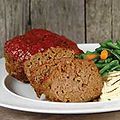Culture of the United States: Difference between revisions
m Reverted edits by 83.55.246.139 (talk) to last revision by Fumitol (HG) |
|||
| Line 24: | Line 24: | ||
|accessdate=2008-10-09}}</ref> Bilingual speakers may use both English and Spanish reasonably well but [[code-switch]] according to their dialog partner or context. Some refer to this phenomenon as [[Spanglish]]. |
|accessdate=2008-10-09}}</ref> Bilingual speakers may use both English and Spanish reasonably well but [[code-switch]] according to their dialog partner or context. Some refer to this phenomenon as [[Spanglish]]. |
||
Indigenous languages of the United States include |
Indigenous languages of the United States include brianna was herethe [[Indigenous languages of the Americas|Native American languages]], which are spoken on the country’s numerous [[Indian reservations]] and Native American cultural events such as [[pow wows]]; [[Hawaiian language|Hawaiian]], which has official status in the state of [[Hawaii]]; [[Chamorro]], which has official status in the commonwealths of [[Guam]] and the [[Northern Mariana Islands]]; [[Carolinian]], which has official status in the commonwealth of the [[Northern Mariana Islands]]; and [[Samoan]], which has official status in the commonwealth of [[American Samoa]]. |
||
===Native Language Statistics for the United States=== |
===Native Language Statistics for the United States=== |
||
Revision as of 13:57, 27 May 2010
This article needs additional citations for verification. (May 2010) |
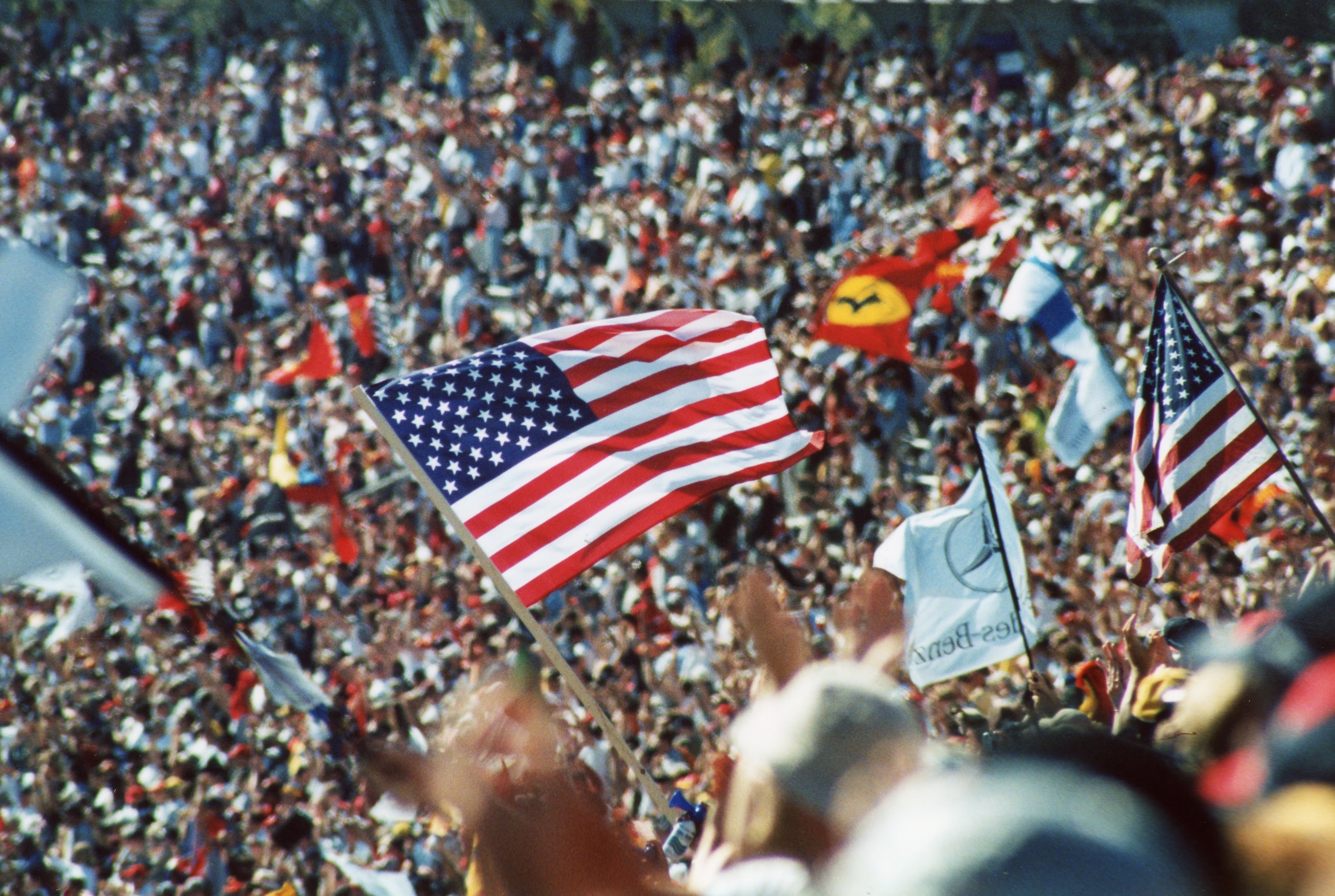
The development of the Culture of the United States of America has been marked by a tension between two strong sources of inspiration: European ideals, especially British; and domestic originality.
American culture encompasses traditions, ideals, customs, beliefs, values, arts, and innovations developed both domestically and imported via British colonization and immigration. Prevalent ideas and ideals which evolved domestically such as important national holidays, uniquely American sports, proud military tradition, and innovations in the arts and entertainment give a strong sense of national pride among the population as a whole.
It includes both conservative and liberal elements, military and scientific competitiveness, political structures, risk taking and free expression, materialist and moral elements.
It also includes elements which evolved from Native Americans, and other ethnic subcultures; most prominently the culture of African American slave descendants and different cultures from Latin America. Many cultural elements, especially popular culture have been exported across the globe through modern mass media where American culture is sometimes resented[citation needed]. A few[which?] of the cultural elements have remained rather exclusive to North America.
Languages
Although the United States has no official language at the federal level, 30 states have passed legislation making English the official language and it is widely considered to be the de facto national language. Spanish has official status in the commonwealth of Puerto Rico and there are several enclaves throughout the country in which Spanish is the primary spoken language.[1] Bilingual speakers may use both English and Spanish reasonably well but code-switch according to their dialog partner or context. Some refer to this phenomenon as Spanglish.
Indigenous languages of the United States include brianna was herethe Native American languages, which are spoken on the country’s numerous Indian reservations and Native American cultural events such as pow wows; Hawaiian, which has official status in the state of Hawaii; Chamorro, which has official status in the commonwealths of Guam and the Northern Mariana Islands; Carolinian, which has official status in the commonwealth of the Northern Mariana Islands; and Samoan, which has official status in the commonwealth of American Samoa.
Native Language Statistics for the United States
The following information is an estimation as actual statistics constantly vary.
According to the CIA,[2] the following is the percent of total population's native languages in the United States:
- English (82.1%)
- Spanish (10.7%)
- Other Indo-European languages (3.8%)
- Other Asian or Pacific Islander languages (2.7%)
- Other languages (0.7%)
Literature

In the eighteenth and early nineteenth centuries, American art and literature took most of its cues from Europe. During its early history, America was a series of British colonies on the eastern coast of the present-day United States. Therefore, its literary tradition begins as linked to the broader tradition of English literature. However, unique American characteristics and the breadth of its production usually now cause it to be considered a separate path and tradition. Writers such as Nathaniel Hawthorne, Edgar Allan Poe, and Henry David Thoreau established a distinctive American literary voice by the middle of the nineteenth century. Mark Twain and poet Walt Whitman were major figures in the century's second half; Emily Dickinson, virtually unknown during her lifetime, would be recognized as America's other essential poet. Eleven U.S. citizens have won the Nobel Prize in Literature, most recently Toni Morrison in 1993. Ernest Hemingway, the 1954 Nobel laureate, is often named as one of the most influential writers of the twentieth century.[3] A work seen as capturing fundamental aspects of the national experience and character—such as Herman Melville's Moby-Dick (1851), Twain's The Adventures of Huckleberry Finn (1885), and F. Scott Fitzgerald's The Great Gatsby (1925)—may be dubbed the "Great American Novel". Popular literary genres such as the Western and hardboiled crime fiction were developed in the United States.
Religion


Among developed countries, the US is one of the most religious in terms of its demographics. According to a 2002 study by the Pew Global Attitudes Project, the US was the only developed nation in the survey where a majority of citizens reported that religion played a "very important" role in their lives, an attitude similar to that found in its neighbors in Latin America.[4]
Several of the original Thirteen Colonies were established by English and Irish settlers who wished to practice their own religion without discrimination or persecution as religious extremists in Europe: Pennsylvania was established by Quakers, Maryland by Roman Catholics and the Massachusetts Bay Colony by Puritans. Nine of the thirteen colonies had official public religions. Yet by the time of the Philadelphia Convention of 1787, the United States became one of the first countries in the world to codify freedom of religion into law, although this originally applied only to the federal government, and not to state governments or their political subdivisions.
Modeling the provisions concerning religion within the Virginia Statute for Religious Freedom, the framers of the United States Constitution rejected any religious test for office, and the First Amendment specifically denied the central government any power to enact any law respecting either an establishment of religion, or prohibiting its free exercise. In following decades, the animating spirit behind the constitution's Establishment Clause led to the disestablishment of the official religions within the member states. The framers were mainly influenced by secular, Enlightenment ideals, but they also considered the pragmatic concerns of minority religious groups who did not want to be under the power or influence of a state religion that did not represent them.[5] Thomas Jefferson, author of the Declaration of Independence said "The priest has been hostile to liberty. He is always in alliance with the despot."[6]
Religious statistics for the United States
It should be noted the following information is an estimation as actual statistics constantly vary.
According to the CIA,[7] the following is the percentage of followers of different religions in the United States:
- Christian: (79.5%)
- Protestant (51.4%)
- Roman Catholic (23.9%)
- Mormon (1.7%)
- Orthodox (1.6%)
- Atheist/Agnostic (3%)
- Jewish (1.7%)
- Buddhist (0.7%)
- Muslim (0.5%)
- Other/Unspecified (14.6%)
National Holidays

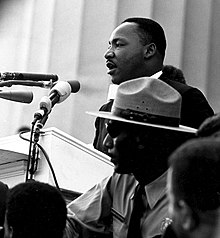


The United States observes holidays derived from events in US history, religious traditions, and national patriarchs.
Thanksgiving has become a traditional American holiday which evolved from the will of English pilgrims to “give thanks” for their welfare. Today, Thanksgiving is generally celebrated as a family reunion with a large afternoon feast. European colonization has led to many traditional Christian holidays such as Easter, Lent, St. Patrick’s Day, and Christmas to be widely observed albeit they are celebrated in a secular manner by many people today.
Independence Day (colloquially known as the Fourth of July) celebrates the anniversary of the country’s Declaration of Independence from the Kingdom of Great Britain. It is generally observed by parades throughout the day and the shooting of fireworks at night.
Halloween is thought to have evolved from the ancient celtic festival of Samhain which was introduced in the American colonies by Irish settlers. It has become a holiday that is widely celebrated by children and teens who traditionally dress up in costumes and go door to door saying the words “Trick or Treat” in exchange for candy. It also brings about an emphasis on eerie and frightening urban legends and movies. The popularity of celebrating Halloween has become continusly popular among university students in the US. Both University of Wisconsin-Madison and Ohio University in Athens, Ohio are known across the US for their Halloween street fairs.
Additionally, Mardi Gras, which evolved from the Catholic tradition of Carnival, is observed notably in New Orleans, St. Louis, and Mobile, AL as well as numerous other towns. Texas still observes the anniversary of its Independence Day from Mexico.
Federally recognized holidays are as follows:
| Date | Official Name | Remarks |
|---|---|---|
| January 1 | New Year's Day | Celebrates beginning of the Gregorian calendar year. Festivities include counting down to midnight (12:00 AM) on the preceding night, New Year's Eve. Traditional end of holiday season. |
| Third Monday in January | Birthday of Martin Luther King, Jr., or Martin Luther King, Jr. Day | Honors Martin Luther King, Jr., Civil Rights leader, who was actually born on January 15, 1929; combined with other holidays in several states. |
| January 20, the first January 20 following a Presidential election | Inauguration Day | Observed only by federal government employees in Washington D.C., and the border counties of Maryland and Virginia, in order to relieve congestion that occurs with this major event. Swearing-in of President of the United States and Vice President of the United States. Celebrated every fourth year. Note: Takes place on January 21 if the 20th is a Sunday (although the President is still privately inaugurated on the 20th). If Inauguration Day falls on a Saturday or a Sunday, the preceding Friday or following Monday is not a Federal Holiday |
| Third Monday in February | Washington's Birthday | Washington's Birthday was first declared a federal holiday by an 1879 act of Congress. The Uniform Holidays Act, 1968, shifted the date of the commemoration of Washington's Birthday from February 22 to the third Monday in February. Many people now refer to this holiday as "Presidents' Day" and consider it a day honoring all American presidents. However, neither the Uniform Holidays Act nor any subsequent law changed the name of the holiday from Washington's Birthday to Presidents' Day.[9] |
| Last Monday in May | Memorial Day | Honors the nation's war dead from the Civil War onwards; marks the unofficial beginning of the summer season. (traditionally May 30, shifted by the Uniform Holidays Act 1968) |
| July 4 | Independence Day | Celebrates Declaration of Independence, also called the Fourth of July. |
| First Monday in September | Labor Day | Celebrates the achievements of workers and the labor movement; marks the unofficial end of the summer season. |
| Second Monday in October | Columbus Day | Honors Christopher Columbus, traditional discoverer of the Americas. In some areas it is also a celebration of Italian culture and heritage. (traditionally October 12); celebrated as American Indian Heritage Day and Fraternal Day in Alabama;[10] celebrated as Native American Day in South Dakota.[11] In Hawaii, it is celebrated as Discoverer's Day, though is not an official state holiday.[12] |
| November 11 | Veterans Day | Honors all veterans of the United States armed forces. A traditional observation is a moment of silence at 11:00 a.m. remembering those killed in war. (Commemorates the 1918 armistice, which began at "the eleventh hour of the eleventh day of the eleventh month.") |
| Fourth Thursday in November | Thanksgiving Day | Traditionally celebrates the giving of thanks for the autumn harvest. Traditionally includes the consumption of a turkey dinner. Traditional start of the holiday season. |
| December 25 | Christmas | Celebrates the Nativity of Jesus. Some people consider aspects of this religious holiday, such as giving gifts and decorating a Christmas tree, to be secular rather than explicitly Christian. |
- Federal Holidays Calendars from the U.S. Office of Personnel Management.
Cuisine
Mainstream American culinary arts are similar to those in other Western countries. Wheat is the primary cereal grain. Traditional American cuisine uses ingredients such as turkey, white-tailed deer venison, potatoes, sweet potatoes, corn, squash, and maple syrup, indigenous foods employed by American Indians and early European settlers. Slow-cooked pork and beef barbecue, crab cakes, potato chips, and chocolate chip cookies are distinctively American styles. Soul food, developed by African slaves, is popular around the South and among many African Americans elsewhere. Syncretic cuisines such as Louisiana creole, Cajun, and Tex-Mex are regionally important. Iconic American dishes such as apple pie, fried chicken, pizza, hamburgers, and hot dogs derive from the recipes of various immigrants and domestic innovations. So-called French fries, Mexican dishes such as burritos and tacos, and pasta dishes freely adapted from Italian sources are widely consumed.[13] Americans generally prefer coffee to tea, with more than half the adult population drinking at least one cup a day.[14] Marketing by U.S. industries is largely responsible for making orange juice and milk (now often fat-reduced) ubiquitous breakfast beverages.[15] During the 1980s and 1990s, Americans' caloric intake rose 24%;[13] frequent dining at fast food outlets is associated with what health officials call the American "obesity epidemic." Highly sweetened soft drinks are widely popular; sugared beverages account for 9% of the average American's daily caloric intake.[16]
Common American Foods
-
Traditional Thanksgiving dinner with Turkey, dressing, sweet potatoes, and cranberry sauce.
-
Typical American seafood with Fried fish, shrimp, hush puppies, and fries.
-
Caesar salad.
-
Hamburger, fries, and a coke.
-
Chicken Fried Steak (alternatively known as Country Fried Steak.)
-
California club pizza with avocados and tomatoes.
-
Toasted turkey sandwich.
-
American style breakfast with pancakes, maple syrup, sausage links, bacon strips, and fried eggs.
-
Canned Spam.
-
A "home-cooked" hot dog sausage with mayonnaise, onion, and pickle-relish.
-
Hickory Smoked Baby Back Ribs.
-
A meatloaf with a tomato sauce topping.
Sports




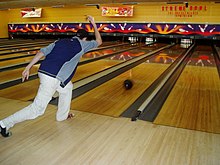
Sports in the United States are an important part of the American culture. However, the sporting culture of the U.S. is unique from that of many other countries. Compared to any other nation, American preferences for sports differ from the rest of the world. For example, professional soccer is not as popular in the United States as it is in many parts of the world.
Baseball is the oldest of the major American teamsports. Professional baseball dates from 1869 and had no close rivals in popularity until the 1960s; though baseball is no longer the most popular sport it is still referred to as the "national pastime." Also unlike the professional levels of the other popular spectator sports in the U.S., Major League Baseball teams play almost every day from April to October. American football now attracts more television viewers than baseball; however, National Football League teams play only 16 regular-season games each year, so baseball is the runaway leader in ticket sales.
Basketball is another major sport, represented professionally by the National Basketball Association. It was invented in Springfield, Massachusetts 1891, by Canadian-born physical education teacher James Naismith.
American football, known in many anglophone countries as gridiron, is widely considered to be the most popular sport in the United States. The 32-team National Football League (NFL) is the most popular and only major professional American football league. Its championship game, the Super Bowl, is the biggest annual sporting event held in the United States. Additional millions also watch college football throughout the autumn months, and some communities, particularly in rural areas, place great emphasis on their local high school team. American football games usually include cheerleaders and marching bands which aim to raise school spirit and entertain the crowd at half-time.
Many Americans recognize a fourth sport - Ice hockey. Always a mainstay of Great Lakes and New England-area culture, the sport gained tenuous footholds in regions like the American South in recent years, as the National Hockey League pursued a policy of expansion.
The quickly growing sport of mixed martial arts has taken off in America since its introduction in the early 1990s. Today, the Ultimate Fighting Championship is one of the most profitable organizations in the country.
Sports and community culture
Homecoming is an annual tradition of the United States. People, towns, high schools and colleges come together, usually in late September or early October, to welcome back former residents and alumni. It is built around a central event, such as a banquet, a parade, and most often, a game of American football, or, on occasion, basketball, or ice hockey. When celebrated by schools, the activities vary widely. However, they usually consist of a football game played on the school's home football field, activities for students and alumni, a parade featuring the school's marching band and sports teams, and the coronation of a Homecoming Queen (and at many schools, a Homecoming King).
Scientific
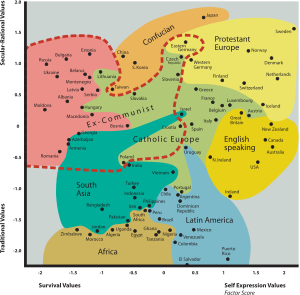
There is a fondness for scientific advancement and technological innovation in American culture. Some of these efforts are centered in Silicon Valley. Other strong scientific areas include nuclear research, space (NASA), military research, and biotech. Respect for scientific advancement still ranks high in the US and the element of competitiveness is exercised as early as in elementary school.
American culture has also made significant gains through the immigration of accomplished scientists. For example, numerous members of the European intelligentsia emigrated during World War II to escape Fascist persecution. At the time, the U.S. was one of the few safe countries to flee to.
Visual arts
In the late eighteenth and early nineteenth centuries, American artists primarily painted landscapes and portraits in a realistic style. A parallel development taking shape in rural America was the American craft movement, which began as a reaction to the Industrial Revolution. Developments in modern art in Europe came to America from exhibitions in New York City such as the Armory Show in 1913. After World War II, New York emerged as a center of the art world. [citation needed]Painting in the United States today covers a vast range of styles.
Architecture
Architecture in the US is regionally diverse and has been shaped by many external forces, not only English. US Architecture can therefore be said to be eclectic, something unsurprising in such a multicultural society.[17] In the absence of a single large-scale architectural influence from indigenous peoples such as those in Mexico or Peru, generations of designers have incorporated influences from around the world. Currently, the overriding theme of American Architecture is modernity: an example of which are the skyscrapers of the 20th century.
Early Neoclassicism accompanied the Founding Father's idealization of European Enlightenment, making it the predominant architectural style for public buildings and large manors. However, in recent years, the suburbanization and mass migration to the Sun Belt has allowed architecture to reflect a Mediterranean style as well.
Sculpture
The history of sculpture in the United States reflects the country's 18th century foundation in Roman republican civic values as well as Protestant Christianity.[citation needed] Perhaps the most iconic American sculpture is the Mount Rushmore National Memorial, an 18m high relief of four US Presidents' faces carved into the granite face of Mount Rushmore.
Popular culture
American popular culture has expressed itself through nearly every medium, including movies, music, and sports.
The U.S. is also popular for evolving/adapting many elements of various other cultures, such as food (i.e. pizza, hamburgers, and hibachi), and television shows (American Idol, Power Rangers).
Fashion
Apart from professional business attire, fashion in the United States is eclectic and predominantly informal. [citation needed]Blue jeans were popularized as work clothes in the 1850s by merchant Levi Strauss, a German immigrant in San Francisco, and adopted by many American teenagers a century later. They are now widely worn in every state by people of all ages and social classes. [citation needed]Along with mass-marketed informal wear in general, blue jeans are arguably U.S. culture's primary contribution to global fashion.[18] The country was also home to the headquarters of many leading designer labels such as Ralph Lauren and Calvin Klein. Labels such as Abercrombie & Fitch, American Eagle, and Hollister cater to various niche markets.
Further iconic items of American fashion are the T-Shirt and the Baseball cap.
Theater
Theater of the United States is based in the Western tradition, mostly borrowed from the performance styles prevalent in Europe, especially England. [citation needed] Today, it is heavily interlaced with American literature, film, television, and music, and it is not uncommon for a single story to appear in all forms. Regions with significant music scenes often have strong theater and comedy traditions as well. Musical theater may be the most popular form: it is certainly the most colorful, and choreographed motions pioneered on stage have found their way onto movie and television screens. Broadway in New York City is generally considered the pinnacle of commercial U.S. theater, though this art form appears all across the country. Off-Broadway and off-off-Broadway diversify the theatre experience in New York. New York's Theater District is also the largest in the country with Cleveland's being the second largest. Another city of particular note is Chicago, which boasts the most diverse and dynamic theater scene in the country. Regional or resident theatres in the United States are professional theatre companies outside of New York City that produce their own seasons. Often tiny rural communities are able to awe audiences with extravagant productions.
Television
Television is one of the major mass media of the United States. Ninety-seven percent of American households have at least one television set and the majority of households have more than three.[citation needed]
The US can be said to be the homeland of modern network television.
Music
American contemporary music can be heard all over the world, through MTV, Channel V, VH1, BET and by artists such as Michael Jackson, Numeriklab,Elvis Presley, Jimi Hendrix, Patsy Cline, Billy Joel, Metallica, Guns N' Roses, Bob Dylan, Creedence Clearwater Revival, Bruce Springsteen, Benny Goodman, Frank Sinatra, Randy Newman, Madonna, Eminem, Backstreet Boys, Rihanna, Dean Martin, Aerosmith, B. B. King, The Doors, Prince, Bon Jovi, Nirvana, Van Halen, Garth Brooks, Weezer, The Killers, The Ramones, Linkin Park, Avenged Sevenfold, Wu-Tang Clan and Green Day. American popular music also contains many styles of music that developed in the US and were popular music when they came up (or still are). Examples are rock & roll, hip-hop, Dance, swing, jazz, blues, country, R&B, funk, pop, and various others.
Films
American films are very popular, including icons like Star Wars, The Godfather, The Karate Kid, Schindler's List, Titanic and The Matrix. American movie actors and actresses are widely recognized such as Tom Hanks, Al Pacino, Julia Roberts, Brad Pitt, Marilyn Monroe, George Clooney, Will Smith, Meryl Streep, Robert De Niro, Leonardo DiCaprio, Denzel Washington, Marlon Brando, Johnny Depp and Clint Eastwood.[citation needed] Outside the US, American Film is usually referred to in a generalizing manner as Hollywood.
Dance
There is great variety in dance in the United States, it is the home of the Lindy Hop and its derivative Rock and Roll, and modern square dance (associated with the United States of America due to its historic development in that country—nineteen U.S. states have designated it as their official state dance) and one of the major centers for modern dance. There is a variety of social dance and concert or performance dance forms with also a range of traditions of Native American dances.
Firearms
In sharp contrast to most other developed nations, firearms laws in the United States are permissive and private gun ownership is common, with about 40% of households containing at least one firearm. In fact, there are more privately owned firearms in the United States than in any other nation on earth, both per capita and in total.[19] Rates of gun ownership vary greatly by region and by state, with gun ownership tending to be most common in Alaska, the Mountain States and the South and least common in Hawaii, the island territories and the Northeast megalopolis.[20] Hunting, plinking and target shooting are popular pastimes, although ownership of firearms purely for utilitarian purposes such as self-defense is common as well. Ownership of handguns, while not uncommon, is less common than ownership of long guns. Gun ownership is much more prevalent among men than women, with men being approximately four times more likely to report owning guns than women.[21]
See also
References
- ^ "Selected Social Characteristics in the United States: 2007". United States Census Bureau. Retrieved 2008-10-09.
- ^ United States, CIA World Factbook.
- ^ Meyers, Jeffrey (1999). Hemingway: A Biography. New York: Da Capo, p. 139. ISBN 0-306-80890-0.
- ^ "U.S. Stands Alone in its Embrace of Religion". Pew Global Attitudes Project. Retrieved 1 January 2007.
- ^ Marsden, George M. 1990. Religion and American Culture. Orlando: Harcourt Brace Jovanovich, pp.45-46.
- ^ Jefferson, Thomas (1904). The writings of Thomas Jefferson. Thomas Jefferson Memorial Association of the United States. p. 119.
- ^ "CIA Fact Book". CIA World Fact Book. 2002. Retrieved 2007-12-30.
- ^ http://www1.macys.com/campaign/parade/parade.jsp
- ^ http://www4.law.cornell.edu/uscode/html/uscode05/usc_sec_05_00006103----000-.html
- ^ "Section 1-3-8".
- ^ "Holidays Observed".
- ^ http://the.honoluluadvertiser.com/article/2007/Oct/08/br/br2504137896.html
- ^ a b Klapthor, James N. (2003-08-23). "What, When, and Where Americans Eat in 2003". Institute of Food Technologists. Retrieved 2007-06-19.
- ^ "Coffee Today". Coffee Country. PBS. 2003. Retrieved 2007-06-19.
{{cite web}}: Unknown parameter|month=ignored (help) - ^ Smith, Andrew F. (2004). The Oxford Encyclopedia of Food and Drink in America. New York: Oxford University Press, pp. 131–32. ISBN 0-19-515437-1. Levenstein, Harvey (2003). Revolution at the Table: The Transformation of the American Diet. Berkeley, Los Angeles, and London: University of California Press, pp. 154–55. ISBN 0-520-23439-1. Pirovano, Tom (2007). "Health & Wellness Trends—The Speculation Is Over". AC Nielsen. Retrieved 2007-06-12.
- ^ "Fast Food, Central Nervous System Insulin Resistance, and Obesity". Arteriosclerosis, Thrombosis, and Vascular Biology. American Heart Association. 2005. Retrieved 2007-06-09. "Let's Eat Out: Americans Weigh Taste, Convenience, and Nutrition" (PDF). U.S. Dept. of Agriculture. Retrieved 2007-06-09.
- ^ Dell Upton. 1998. "Architecture in the United States-Oxford history of art." pp. 11 ff. ISBN 019284217X
- ^ Davis, Fred (1992). Fashion, Culture, and Identity. Chicago: University of Chicago Press, p. 69. ISBN 0-226-13809-7.
- ^ "U.S. most armed country with 90 guns per 100 people". Reuters.
- ^ "Gun Ownership by State". Washington Post.
{{cite web}}: Italic or bold markup not allowed in:|publisher=(help) - ^ "The US gun stock: results from the 2004 national firearms survey". Injury Prevention Journal.
{{cite web}}: Italic or bold markup not allowed in:|publisher=(help)











